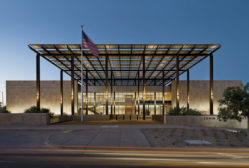Articles by Joann Gonchar, FAIA
Three projects under construction in North America demonstrate that timber can be used as an alternative to concrete, steel, and even masonry.
Read More
Kinetic Architecture: Designs for Active Envelopes
By Russell Fortmeyer and Charles D. Linn
Read More
The New Master Builders
Architects warm to a project delivery method that makes them more integral to the construction process and reasserts their control over the final product.
Read More
Sun Valley House
A Split With Tradition: Making the most of its spectacular setting, a house in a mountain resort town cracks open an everyday form.
Read More
Pearl River Tower
Towering Ambition: The architects and engineers behind an office building in rapidly expanding Guangzhou put super green before supertall.
Read More
Thurgood Marshall U.S. Courthouse
Order in the Court: A multidisciplinary design team applies a light and skillful touch to restore luster to a faded Lower Manhattan landmark while bringing it up to current standards.
Read More
Modular Classroom Makeover
New designs for portable school buildings make improvements that are more than cosmetic.
Read More
Marc Fornes/TheVeryMany
A small studio deploys computational design and digital fabrication to make inventive structures that define space.
Read More
Krishna P. Singh Center for Nanotechnology
The Art of Science: A new center for the study of nanotechnology merges landscape with building, and sculpture with architecture, reshaping a formerly bleak part of the University of Pennsylvania campus.
Read More
Copyright ©2024. All Rights Reserved BNP Media.
Design, CMS, Hosting & Web Development :: ePublishing


